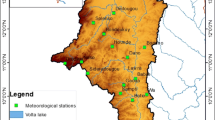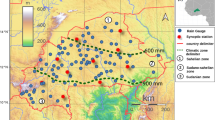Abstract
Measuring rainfall from space appears to be the only cost effective and viable means in estimating regional precipitation over the Tibet, and the satellite rainfall products are essential to hydrological and agricultural modeling. A long-standing problem in the meteorological and hydrological studies is that there is only a sparse raingauge network representing the spatial distribution of precipitation and its quantity on small scales over the Tibet. Therefore, satellite derived quantitative precipitation estimates are extremely useful for obtaining rainfall patterns that can be used by hydrological models to produce forecasts of river discharge and to delineate the flood hazard area. In this paper, validation of the US National Oceanic and Atmospheric Administration (NOAA) Climate Prediction Center (CPC) RFE (rainfall estimate) 2.0 data was made by using daily rainfall observations at 11 weather stations over different climate zones from southeast to northwest of the Tibet during the rainy season from 1 June to 30 September 2005 and 2006. Analysis on the time series of daily rainfall of RFE-CPC and observed data in different climate zones reveals that the mean correlation coefficients between satellite estimated and observed rainfall is 0.74. Only at Pali and Nielamu stations located in the southern brink of the Tibet along the Himalayan Mountains, are the correlation coefficients less than 0.62. In addition, continuous validations show that the RFE performed well in different climate zones, with considerably low mean error (ME) and root mean square error (RMSE) scores except at Nielamu station along the Himalayan range. Likewise, for the dichotomous validation, at most stations over the Tibet, the probability of detection (POD) values is above 73% while the false alarm rate (FAR) is between 1% and 12%. Overall, NOAA CPC RFE 2.0 products performed well in the estimation and monitoring of rainfall over the Tibet and can be used to analyze the precipitation pattern, produce discharge forecast, and delineate the flood hazard area.
Similar content being viewed by others
References
Arkin, P. A., and B. N. Meisner, 1987: The relationship between large-scale convective rainfall and cold cloud over the Western Hemisphere during 1982–1984. Mon. Wea. Rev., 115(1), 51–74.
—, and P. E. Ardanuy, 1989: Estimating climatic-scale precipitation from space: A review. J. Climate, 2, 1229–1238.
Bajracharya, S. R., M. S. Shrestha, S. Thapa, et al., 2008: Validation of satellite rainfall estimation in the summer monsoon dominated area of the Hindu Kush-Himalayan region. Proc. 4th International Precipitation Working Group Workshop, National Satellite Meteorological Center, Chinese Meteorological Administration, 26–37.
Barrett, E. C., and D. W. Martin, 1981: The Use of Satellites in Rainfall Monitoring. Academic Press, London, 340 pp.
Beyene, E. G., and B. Meissner, 2010: Spatio-temporal analyses of correlation between NOAA satellite RFE and weather stations’ rainfall record in Ethiopia. International Journal of Applied Earth Observation and Geoinformation, 12(Suppl.), 69–75.
Dinku, T., S. Chidzambwa, P. Ceccato, et al., 2008: Validation of high-resolution satellite rainfall products over complex topography. Int. J. Remote Sensing, 29(14), 4107–4109.
Ebert, E. E., J. E. Janowiak, and C. Kidd, 2007: Comparison of near real-time precipitation estimates from satellite observations and numerical models. Bull. Amer. Meteor. Soc., 88, 47–64.
Ferraro, R. R., and G. F. Marks, 1995: The development of SSM/I rain rate retrieval algorithms using ground-based radar measurements. J. Atmos. Oceanic Technol., 12, 775–780.
—, N. C. Grody, F. Weng, et al., 1996: An eight-year (1987–1994) time series of rainfall, clouds, water vapor, snow cover, and sea ice derived from SSM/I measurements. Bull. Amer. Meteor. Soc., 77(5), 891–906.
Funk, C., and J. Verdin, 2003: Comparing satellite rainfall estimates and reanalysis precipitation fields with station data for western Kenya. Proc. Int. Workshop on CropMonitoring for Food Security in Africa. European Joint Research Centre/UN Food and Agriculture Organization, 89–95.
Kamarianakis, Y., N. Chrysoulakis, H. Feidas, et al., 2006: Comparing rainfall estimates derived from rain gages and satellite images at the eastern Mediterranean region. Proc. 9th AGILE Conference on Geographic Information Science: Shaping the future of Geographic Information Science in Europe, 15–20.
Shrestha, M. S., S. R. Bajracharya, and P. K. Mool, 2008: Satellite rainfall estimation in the Hindu Kush-Himalayan region. International Centre for Integrated Mountain Development (ICIMOD), Kathmandu, 3–4.
The Scientific Expedition to Tibetan Plateau, 1984: Climate in Tibet. Science Press, Beijing, 43–44.
Xie, P., and P. A. Arkin, 1996: Analysis of global monthly precipitation using gauge observations, satellite estimates, and numerical model prediction. J. Climate, 9, 840–858.
—, and —, 1997: Global precipitation: A 17-year monthly analysis based on gauge observations, satellite estimates, and numberical model outputs. Bull. Amer. Meteor. Sor., 78, 2539–2558.
Zhao, L., R. Ferraro, and D. Moore, 2000: Validation of NOAA-15 AMSU-A rain rate algorithms. 10th Conf. on Satellite Meteor., 192–195.
Author information
Authors and Affiliations
Corresponding author
Additional information
Supported by the Chengdu Institute of Plateau Meteorology of China Meteorological Administration (LPM2010003), Key Project of Tibet Department of Science and Technology, and Satellite Rainfall Estimation Project of the International Centre for Integrated Mountain Development.
Rights and permissions
About this article
Cite this article
Chu, D., Pubu, T., Norbu, G. et al. Validation of the satellite-derived rainfall estimates over the Tibet. Acta Meteorol Sin 25, 734–741 (2011). https://doi.org/10.1007/s13351-011-0604-8
Received:
Accepted:
Published:
Issue Date:
DOI: https://doi.org/10.1007/s13351-011-0604-8




